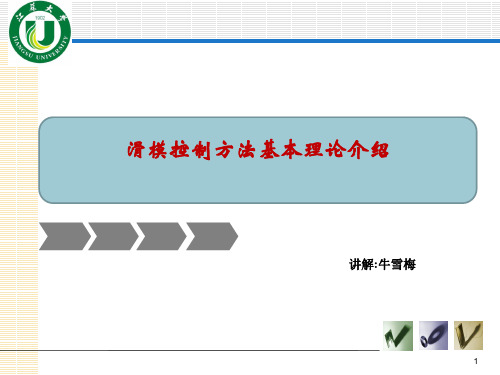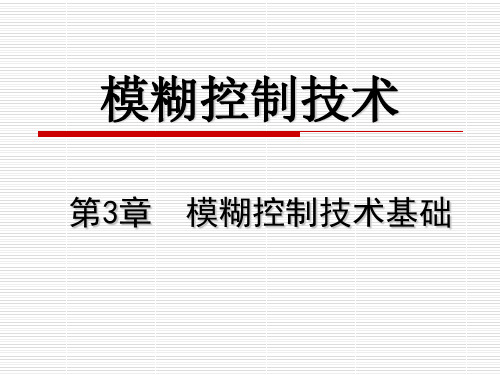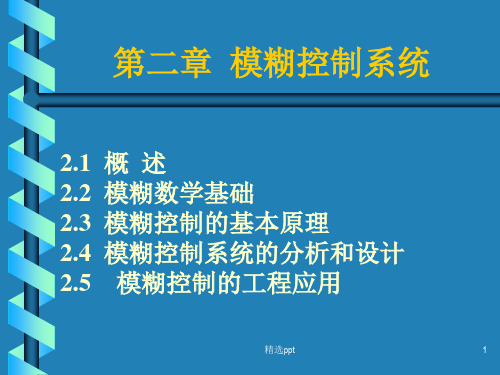模糊滑模控制 PPT
合集下载
滑模理论及其控制实例ppt课件

x2 s0
•
O(0,0)
s0 x1
s0
•A
x•0
图1 滑模控制示意图
从定义中可以看出,设计变构控制的基本步骤,它包括两个相对部分,即寻求
切换函数s(x)和寻求控制量 u (x)和u (x) 。
8
滑模控制的特性:
1)设计反馈u(x),限定是变结构的,它能将系统的运动引导到一个超平面 s(x)=0上。且系统在该滑模面上的运动是渐进稳定的。
s0 x1
s0
•A
x•0
图1 滑模控制示意图
6
滑模控制器的设计思想:设计一个控制器,将从任一点出发的状态轨线 通过控制作用拉到滑模面上,然后沿着此滑模面滑动到原点。
根据所确定的滑模面函数 s(x),设计如下形式控制律
u
u
u
( (
x) , x),
s(x) 0 s(x) 0
其中 u (x) u (x) ,使得系统在任何初始点都能在有限时间内到达滑模面,
在机器人、航空航天、电力系统、伺服系统等领域得到了广泛应用。
3
基本概念
变结构控制是一类特殊的非线性控制,其非线性表现为控制作用的不 连续性。与其他控制策略的不同之处:系统的“结构”并不固定,而是在 动态过程中,根据系统当前的状态有目的地不断变化。
结构的变化若能启动“滑动模态”运动,称这样的控制为滑模控制。 注意:不是所有的变结构控制都能滑模控制,而滑模控制是变结构控制中 最主流的设计方法。
u
u u
( (
x) , x),
s(x) 0 s(x) 0
u Rm,t R
5)什么条件下可以确保滑动模态运动的存在以及系统在进入滑动模态运动 以后能具有良好的动态特性如渐近稳定等,是变结构控制理论所要研究 的主要问题。
模糊控制课件第三章.ppt

其基本思想:对于训练样本(包括论域内若干 个测量点上的状态数据以及相应隶属于人类 经验的被测量,用自然语言符号描述的状态 符号),在当前概念模式下,根据最大隶属度 准则判定,若数据状态与概念状态相一致, 则训练结束;若不相符,则将相应概念隶属 函数曲线的修正率加以改变,以实现符合专 家经验的被测量数据状态与符号状态的一致。
If X1 is 大 and X2 is 小 then Y is 中
仿照蕴含式的称谓“X1 is 大 and X2 is 小” 称为控制规则的前件部,“Y is 中”称为控 制规则的后件部。
“大”、“小”、“中”等均是对某一物理 量的模糊化的自然语言描述,但它们均被描 述成一个模糊集合。
模糊控制是一种基于人的思维模式的控制, 因此,在模糊控制规则中出现的模糊集合往 往具有可以用自然语言描述的意义。
用于描述人们控制经验的基本语句结构有 三种形式,它们分别反映了三种基本的推 理。这三种基本结构和形式如下:
这种推理是一种最简单的蕴涵关系,在语
言表达时表示为“如果 A,那么B ”,即
有:if A then B
~
~
② (A B) (AC C)结构
~
~
~
~
这种推理较之前一种复杂,这种蕴涵关系在 用语言表达时叙述为“如果 A,那么B;否则 C ”,即有:
左边最大隶属度法,实质是把几个最大隶属 度中的最小元素作为解模糊的精确值;右边 最大隶属度法,实质是把几个最大隶属度中 的最大元素作为解模糊后的精确值。
3.3.3 系数加权平均法
系数加权平均法是指输出量模糊集合中各元 素进行加权平均后的输出值作为输出执行量, 其值为:
(3.7)
当输出变量为离散单点集时,则为:
模糊控制ppt课件

可编辑课件PPT
23
5. 建立模糊控制表 模糊控制规则可采用模糊规则表4-5来描述,共
49条模糊规则,各个模糊语句之间是或的关系,由第 一条语句所确定的控制规则可以计算出u1。同理,可 以由其余各条语句分别求出控制量u2,…,u49,则控制 量为模糊集合U可表示为
uu1u2 u49
可编辑课件PPT
规则模型化,然后运用推理便可对PID参数实现最佳
调整。
可编辑课件PPT
32
由于操作者经验不易精确描述,控制过程中各种 信号量以及评价指标不易定量表示,所以人们运用 模糊数学的基本理论和方法,把规则的条件、操作 用模糊集表示,并把这些模糊控制规则以及有关信 息(如初始PID参数等)作为知识存入计算机知识库中 ,然后计算机根据控制系统的实际响应情况,运用 模糊推理,即可自动实现对PID参数的最佳调整,这 就是模糊自适应PID控制,其结构如图4-15所示。
可编辑课件PPT
31
随着计算机技术的发展,人们利用人工智能的
方法将操作人员的调整经验作为知识存入计算机中
,根据现场实际情况,计算机能自动调整PID参数,
这样就出现了智能PID控制器。这种控制器把古典的
PID控制与先进的专家系统相结合,实现系统的最佳
控制。这种控制必须精确地确定对象模型,首先将
操作人员(专家)长期实践积累的经验知识用控制
糊控制的维数。
可编辑课件PPT
10
(1)一维模糊控制器 如图所示,一维模糊控制器的 输入变量往往选择为受控量和输入给定的偏差量E。由 于仅仅采用偏差值,很难反映过程的动态特性品质, 因此,所能获得的系统动态性能是不能令人满意的。 这种一维模糊控制器往往被用于一阶被控对象。
可编辑课件PPT
模糊控制与模糊策略讲义课件(ppt 78页)

若uj在第i 种意见vi中排第k位,设第k位的权重 为ak,则令Bi(uj)= ak(n – k ),称
m
B(uj) Bi(uj)
i1
为uj的加权Borda数。
名次
一
二
三
四
五
六
权重
0.35
0.25
0.18
0.11
0.07
0.04
B(u1)=7, B(u2)=5.75, B(u3)=1.98, B(u4)=1.91, B(u5)=0.51, B(u6)=0.75.
得到模糊控制量 。u~
❖ 模糊控制量清晰化,对对象进行一步控制,等到
第二次采样。
2/7/2020
^_^
6
❖ 范例:某电热炉用于对金属零件的热处理,要求保持炉 温600度恒定不变。
根据人工经验,控制规则可用语言描述如下。
若炉温低于600度则升压,低得越多升压越高;
若炉温高于600度则降压,高得越多降压越低;
+(0.5/0)+(0.5/1)+(0/2)+(0/3) 对上式控制量的模糊子集按照隶属度最大 原则,取控制量为-1级,即当炉温偏高时,应 降一点电压。
2/7/2020
^_^
13
模糊控制器设计的基本方法
❖ 1. 模糊控制器的结构设计 确定模糊控制器的输入、输出变量
(1)人机系统中的信息量:误差、误差变化、 误差变化的变化,以及人控制动作的输出量 (2)模糊控制器的输入、输出变量
2/7/2020
^_^
35
❖ 5.论域、量化因子、比例因子的选择
基本论域、模糊子集的论域、模糊语言 词集的总数(7、8)
Ke=n/xe;Kc=m/xc;量化因子一般远 大于1。Ku=yu/l,比例因子。
《模糊滑模控制》课件

03
滑模控制
滑模控制的基本概念
滑模控制是一种变结构控制方 法,通过不断改变系统的结构
来达到控制目标。
它利用滑动模态的概念,使 系统在动态过程中按照预设 的滑模面运动,从而实现快
速、稳定的控制。
滑模控制具有对参数变化和外 部扰动不敏感的优点,因此在
许多领域得到广泛应用。
滑模控的设计和控制律的设计两 个部分。
详细描述
在机器人控制系统中,模糊滑模控制通过 构建机器人的运动学模型和动力学模型, 实现了对机器人运动的精确控制。它能够 根据环境变化自适应调整机器人的运动轨 迹和姿态,提高了机器人在复杂环境下的 适应性和稳定性。
飞行器控制系统中的应用
总结词
飞行器控制系统需要保证飞行的安全性和稳 定性,模糊滑模控制能够提高飞行器的导航 精度和抗风扰能力。
技术挑战
解决模糊滑模控制中的计算负担 问题,提高其实时性能。
应用前景
拓展模糊滑模控制在机器人控制 、航空航天、智能制造等领域的 应用,提高系统的性能和稳定性 。
01
研究重点
进一步研究模糊滑模控制在复杂 系统中的应用,如多变量系统、 非线性系统等。
02
03
发展方向
结合深度学习、强化学习等先进 技术,提升模糊滑模控制的自适 应性和智能性。
模糊滑模控制的优缺点总结
01
缺点:
02
计算负担:模糊逻辑需要一定的计算资源,对于高速实时系统可能存 在计算负担问题。
03
缺乏精确性:由于模糊逻辑的近似推理,其结果可能不如传统滑模控 制精确。
04
对初始状态敏感:模糊逻辑对系统的初始状态较为敏感,可能导致系 统状态在切换过程中出现震荡。
未来研究方向与展望
《模糊控制系统》PPT课件

是所期望的。这促使我们研究模糊系统作为万能
函数逼近器并拥有最小系统构成的必要条件,从
而使这些必要条件能用于指导模糊系统开发者设
计更紧凑的模糊控制器和模糊模型
• 必要条件设置了需要的输入模糊集、输出模糊集 和模糊规则,表明了模糊系统需要的输入模糊集
和模糊规则的数目依赖于被逼近函数的极值点的
数目和位置
精选ppt
“Fuzzy Sets”一文,首次提出了模糊集合的概念
• 1974年英国教授Mamdani首次将模糊集合理论应
用于加热器的控制,他将基于规则系统的想法与
模糊参数相结合来构造控制器,模仿人类操作者
的操作经验
• 1985年Takagi和Sugeno提出了另一类具有线性规
则后项的模糊控制器,称之为Takagi-Sugeno
(1988, Japan)
• Postsurgical patients
(1989, USA)
• Auto focus video camera
(1990, Japan)
• Washing machines
(1990, Japan)
• Air conditioners
(1990, Japan)
• Anti-shaking video camera
控制规律
• 各种类型的Mamdani和TS模糊系统在过去几年中
都被证明是万能逼近器,它们能一致逼近定义在
闭定义域D上的任意连续函数到任意高的逼近精
度。这些模糊系统有:加法模糊规则系统、模糊
输入—输出控制器、Sugeno模糊控制器的变型、
非独点模糊逻辑系统、一般Mamdani型模糊系统、
采用线性规则后项的TS型模糊系统、广义模糊系
模糊控制算法PPT课件
模糊控制理论在
-
1
一、概述
二、在汽车上的应用方面
三、举例说明在汽车空调当中的应用
四、简要介绍在其他方面的应用
-
2
一、概 述
1、什么叫模糊控制?
所谓模糊控制,就是对难以用已有规律描述的复 杂系统,采用自然语言(如大、中、小)加以叙 述,借助定性的、不精确的及模糊的条件语句来 表达,
模糊控制是一种基于语言的一种智能控制
正小PS(Positive Small)、
正中PM(Positive Medium),
正大PB(Positive Big),
则:
T(E)= {NB,NM,NS,- ZE,PS,PM,PB}
13
X
建立隶属函数:
各参数对相应子集的隶属函数分别由不同的函数族决定。参数的相应 子集指该参数被人为地划分成的等级所构成的一组模糊集合。相应子 集的多少,由控制精度决定。
-
8
3、模糊控制的特点
①适用于不易获得精确数学模型的被控 对象,
②是一种语言变量控制器 ③从属于智能控制的范畴。该系统尤其 适于非线性,时变,滞后系统的控制 ④抗干扰能力强,响应速度快,并对系 统参数的变化有较强的鲁棒性。
-
9
二、模糊控制在汽车的应用方面
1、ABS防抱死系统工况的多变及轮胎的非线性 2、汽车巡航系统外界负荷的扰动、汽车质量和传动系效率的不确
-
12
模糊控制是基于语言的控制 模糊语言集的组成: T(E)
T(E)={负大,负中,负小,零,正小,正中,正大}
用模糊语言变量E 来描述偏差,
或用符号表示
负大NB(Negative Big)、
负中NM(Negative Medium)、
-
1
一、概述
二、在汽车上的应用方面
三、举例说明在汽车空调当中的应用
四、简要介绍在其他方面的应用
-
2
一、概 述
1、什么叫模糊控制?
所谓模糊控制,就是对难以用已有规律描述的复 杂系统,采用自然语言(如大、中、小)加以叙 述,借助定性的、不精确的及模糊的条件语句来 表达,
模糊控制是一种基于语言的一种智能控制
正小PS(Positive Small)、
正中PM(Positive Medium),
正大PB(Positive Big),
则:
T(E)= {NB,NM,NS,- ZE,PS,PM,PB}
13
X
建立隶属函数:
各参数对相应子集的隶属函数分别由不同的函数族决定。参数的相应 子集指该参数被人为地划分成的等级所构成的一组模糊集合。相应子 集的多少,由控制精度决定。
-
8
3、模糊控制的特点
①适用于不易获得精确数学模型的被控 对象,
②是一种语言变量控制器 ③从属于智能控制的范畴。该系统尤其 适于非线性,时变,滞后系统的控制 ④抗干扰能力强,响应速度快,并对系 统参数的变化有较强的鲁棒性。
-
9
二、模糊控制在汽车的应用方面
1、ABS防抱死系统工况的多变及轮胎的非线性 2、汽车巡航系统外界负荷的扰动、汽车质量和传动系效率的不确
-
12
模糊控制是基于语言的控制 模糊语言集的组成: T(E)
T(E)={负大,负中,负小,零,正小,正中,正大}
用模糊语言变量E 来描述偏差,
或用符号表示
负大NB(Negative Big)、
负中NM(Negative Medium)、
滑模变结构控制基本理论课件PPT学习教案
因为,c1 15 0, 所以上式收敛到零,且仅与c1有关,而与对象参数无关[不变性]。
第4页/共14页
5
滑模变结构控制基本理论
图1 滑模面运动相轨迹
图2 X1运动轨迹
图3 X2运动轨迹
图4 滑模面运动轨迹
第5页/共14页
6
滑模变结构控制基本理论
图5 控制器u(t)轨迹
图6 控制器u(t)局部轨迹
方法:趋近律求u(t): S sgn(s) f (s)
式中 f (s) ks, k 0, 0 显然 ss ssgn(s) ks2 s ks2 0
第3页/共14页
4
滑模变结构控制基本理论
又 s Cx C[Ax(t) Bu(t)] sgn(s) ks
解之 u(t) (CB)1(CAx s) (CB)1[CAx ( sgn(s) ks)]
10
滑模变结构控制基本理论
定义滑模面: s1 e1 x1 xˆ1
s2 e2 x2 xˆ2
e1 x1 xˆ1 x2 xˆ2 v1 e2 v1
e2 x2 xˆ2 25e2 fa (t) v2
因为 e1e1 e1(e2 v1) e1e2 k1e1 sgn e1 e1e2 k1 e1 e1 e2 k1 e1 e1 e2 k1
滑模变结构控制基本理论课件
会计学
1
滑模变结构控制基本理论
设计目标
设有一非线性系统: x f (x,u,t)
•滑模面 选择一个系统在有限时间内可以到达并维持在其上运动的子流形,即 —
滑模面s(x);
•控制律 求取一个可以强迫系统进入滑动模态的控制律 —
ui
ui
(
x)
ui
(
x)
模糊控制 PPT课件
A (27) %
lim
n
27
青年人*的次数 n
101 129
0.78
上一页 下一页
隶属函数的确定
求取论域中足够多元素的隶属度,根据这些隶属度求出 隶属函数。具体步骤为:
①求取论域中足够多元素的隶属度;
② 求隶属函数曲线。以论域元素为横坐标,隶属度为纵坐 标,画出足够多元素的隶属度(点),将这些点连起来, 得到所求模糊结合的隶属函数曲线;
B×A={(1, a) (1, b) (1, c) (2, a) (2, b) (2, c)}
上一页 下一9页
2.2 模糊集合及其运算规则
在普通集合中,论域中的元素(如a)与集合(如A)之间的关系是属
于(a∈A),或者不属于(a A),它所描述的是非此即彼的清晰概念。
但在现实生活中并不是所有的事物都能用清晰的概念来描述,如:
曲线非常接近。此时取α=1/25,a=24.5,β=2。参数修改后
~ 的降半哥西型函数即为模糊集合“青年人”的隶属函数。即:
1
~ 青年人(x)
1
(
x
1 24.5)2
5
18 x 24 24 x 100
上一页 下一20页
3) 模糊集合的并、交、补运算
设 A、B 为论域U上的两个模糊集合。则 A 与B 的并集(
+
传感器 测量的 当前值
计算机 自动给出
根据当前的状 态,对照控制 经验,给出适 当的控制量
事先总结归
纳出一套完
整的控制规
传感器 模糊推理判决
则,放在计 + 测量的
计算出
控制量
算机中。
当前值
上一页 下一页
5.2 模糊控制发展的三个阶段
《模糊滑模控制》课件
模糊滑模控制介绍
模糊滑模控制是将模糊控制和滑模控制相结合的一种控制方法。它综合了两种方法的优点,在处理非线性和不 确定性系统时表现出色。
模糊滑模控制的设计方法
模糊滑模控制的设计方法包括模糊建模、滑模面设计和控制规则的制定。这 些步骤共同构成了一个全面而有效的控制系统设计过程。
模糊滑模控制的应用领域
模糊滑模控制在各个领域有着广泛的应用,如机械控制、电力系统、交通运输等。其灵活性和鲁棒性使ቤተ መጻሕፍቲ ባይዱ它成 为解决复杂系统控制问题的重要工具。
总结和展望
通过模糊滑模控制,我们能够更好地应对复杂系统的控制需求。未来,随着 技术的发展,模糊滑模控制将进一步完善和扩大应用范围。
《模糊滑模控制》PPT课 件
控制理论基础
模糊控制概述
通过结合模糊逻辑和控制理论,模糊控制可以处理一些复杂且难以描述的系 统。它提供了一种不确定性沉淀的方法,使控制系统能够适应不同的环境变 化。
滑模控制概述
滑模控制是一种通过引入滑模面来实现对系统状态的控制方法。它具有强鲁棒性和快速响应的特点,可以有效 地抵抗外界干扰和系统参数变化。
- 1、下载文档前请自行甄别文档内容的完整性,平台不提供额外的编辑、内容补充、找答案等附加服务。
- 2、"仅部分预览"的文档,不可在线预览部分如存在完整性等问题,可反馈申请退款(可完整预览的文档不适用该条件!)。
- 3、如文档侵犯您的权益,请联系客服反馈,我们会尽快为您处理(人工客服工作时间:9:00-18:30)。
quite difficult to further improve the reliability of a component even if the reliability is considerably lower than desired.
Fuzzy arithmetic based reliability allocation approach during early design and development
初期阶段的设计和发展中基于模糊算法的可靠度分配方法
V. Sriramdas , S.K. Chaturvedi , H. Gargama
Ri= factor wi (权重因子)can be expressed with
proportionality factor Zi(比例因子)as:
wi = Zi /∑Zi
(2)
4
2.1. Complexity(复杂度) The complexity factor varies from subsystem to subsystem within a system and is measured in terms of number of active components that a subsystem is composed of. The number of components in a subsystem has a direct bearing on the reliability of the subsystem. Thus, complexity has a strong impact on the reliability allocation. The failure rate of the subsystem with high complexity is generally going to be high. So, the failure rate is allocated proportional to the complexity of the subsystem. Hence, Zi ∝ Ki, where Ki is the complexity factor for the its subsystem.
2.Factors based conventional reliability allocation method
In this allocation method, the target reliability based on the reliability
factors is apportioned to subsystems for which no predicted reliability
Hence, Zi ∝Coi, where Coi is the cost factor for the its subsystem.
2.3. State-of-the-art(工艺状态) When the component has been available for a long time, it is
values are known. The relationship between apportioned reliability of ith
subsystem Ri (子系统可靠度)and target system reliability R*(总系统可 靠度) is defined with a weightage factor wi.
1. Multiple functional relationships with the other groups. 2. Number of components comprising subsystem.
5
2.2. Cost(成本)
For a large system, the cost increment for reliability improvement is relatively high. The demonstration of a high reliability value for a costly system may be extremely uneconomical.
1.Introduction
Reliability allocation is an important and iterative task during the design and development activities of any engineering system. It is also difficult task because of the obscured and incomplete design details and a number of factors have to consider in design process. During the design phase of a system with a specified target reliability level, the reliability levels of the subsystems affect the overall system reliability. Therefore, a proper reliability allocation method needs to be adopted to allocate the target system reliability to its constituent subsystems proportionately.
1.Introduction 2.Factors based conventional reliability allocation method 3.Fuzzy numbers and arithmetic 4.The methodology 5.Illustrative example 6.Conclusions
Fuzzy arithmetic based reliability allocation approach during early design and development
初期阶段的设计和发展中基于模糊算法的可靠度分配方法
V. Sriramdas , S.K. Chaturvedi , H. Gargama
Ri= factor wi (权重因子)can be expressed with
proportionality factor Zi(比例因子)as:
wi = Zi /∑Zi
(2)
4
2.1. Complexity(复杂度) The complexity factor varies from subsystem to subsystem within a system and is measured in terms of number of active components that a subsystem is composed of. The number of components in a subsystem has a direct bearing on the reliability of the subsystem. Thus, complexity has a strong impact on the reliability allocation. The failure rate of the subsystem with high complexity is generally going to be high. So, the failure rate is allocated proportional to the complexity of the subsystem. Hence, Zi ∝ Ki, where Ki is the complexity factor for the its subsystem.
2.Factors based conventional reliability allocation method
In this allocation method, the target reliability based on the reliability
factors is apportioned to subsystems for which no predicted reliability
Hence, Zi ∝Coi, where Coi is the cost factor for the its subsystem.
2.3. State-of-the-art(工艺状态) When the component has been available for a long time, it is
values are known. The relationship between apportioned reliability of ith
subsystem Ri (子系统可靠度)and target system reliability R*(总系统可 靠度) is defined with a weightage factor wi.
1. Multiple functional relationships with the other groups. 2. Number of components comprising subsystem.
5
2.2. Cost(成本)
For a large system, the cost increment for reliability improvement is relatively high. The demonstration of a high reliability value for a costly system may be extremely uneconomical.
1.Introduction
Reliability allocation is an important and iterative task during the design and development activities of any engineering system. It is also difficult task because of the obscured and incomplete design details and a number of factors have to consider in design process. During the design phase of a system with a specified target reliability level, the reliability levels of the subsystems affect the overall system reliability. Therefore, a proper reliability allocation method needs to be adopted to allocate the target system reliability to its constituent subsystems proportionately.
1.Introduction 2.Factors based conventional reliability allocation method 3.Fuzzy numbers and arithmetic 4.The methodology 5.Illustrative example 6.Conclusions
